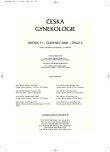-
Medical journals
- Career
Birth Defects’ Occurrence in Offspring of Mothers Taking 1st Trimester Medication in the Czech Republic in 1996-2004
Authors: A. Šípek 1,2; V. Gregor 3,4; J. Horáček 3,4; D. Mašátová 5
Authors‘ workplace: Ústav pro péči o matku a dítě, Praha, ředitel doc. MUDr. J. Feyereisl, CSc. 1; Institut postgraduálního vzdělávání ve zdravotnictví, Praha, Katedra gyn. -por., ředitel MUDr. A. Malina, Ph. D. 2; Oddělení lékařské genetiky, Fakultní Thomayerova nemocnice, Praha, ředitel MUDr. P. Malý 3; Institut postgraduálního vzdělávání ve zdravotnictví, Praha, Katedra lékařské genetiky ředitel MUDr. A. Malina, Ph. D. 4; Ústav zdravotnických informací a statistiky České republiky, Praha, ředitelka Mgr. V. Mazánková 5
Published in: Ceska Gynekol 2006; 71(4): 284-291
Category: Original Article
Overview
Objective:
An analysis of birth defects incidence in offspring of mothers taking 1st trimester medication in the Czech Republic in 1996-2004.Type of study:
A retrospective demographical – epidemiological analysis of data from a National Register of Congenital Anomalies of the Czech Republic.Methodology:
Data on birth defects in the Czech Republic from the Institute of Health Information and Statistics - National Register of Congenital Anomalies from the 1996 – 2004 period and a control group data on healthy children born to mothers taking medications from the same time period. Data on medication were analyzed in relation to particular defects and were also used in international databases.Results:
There were 1,125 children born with a birth defect to mothers taking 1st trimester medication making a total of 1,456 particular birth defects. A control group covered 1,321 exposed women giving birth to a child without any birth defect. Some types of congenital heart defects, cleft lip with cleft palate and limb reduction defects. A significantly higher risk was found also in following 5 types of drugs: anticoagulants, antihypertensives, peripheral vasodilatants, urologics and antiepileptics.Conclusions:
A significantly higher risk was found for the following defects: anencephaly, spina bifida, congenital hydrocephalus, anophthalmia/microphthalmia and auricular and limb reduction defects. Although the results are not always unambiguous and are probably influenced by both information and recall bias, they complement data on adverse effects of drugs in pregnancy in the Czech Republic. They also stress the need for a high preliminary caution in drug prescription and for a complex and individual risk assessement by a clinical geneticist.Key words:
birth defect, populational teratology, teratogen, incidence, Czech Republic
Labels
Paediatric gynaecology Gynaecology and obstetrics Reproduction medicine
Article was published inCzech Gynaecology

2006 Issue 4-
All articles in this issue
- Gynecological Aspects of Thyroid Disorders. A Review
- Assisted Reproduction in Patients with Food Intake Disorders – Clinical and Ethical Aspects
- Present Occurrence of Benign Teratoma of Ovary and Fallopian Tube in a Patient with Adnexal Torsion
- Massive Breast Angiomatosis with Dramatic Course Leading to Acute Total Mastectomy – A Case Report
- Vulval Oedema as the First Sign of Crohnęs Diseas – Case Reports
- Harmatoma of the Breast – Case Report
- Molecular Prognostic Factors and Pathogenesis of Endometrial Cancer
- Intrapartal Fetal Monitoring, Sensitivity and Specificity of Methods
- Role of ST-Analysis of Fetal ECG in Intrapartal Fetus Monitoring with Presumed Growth Retardation
- Actual Management of Pregnancies at Risk for Fetal Anemia
- Rapid Detection of Most Frequent Chromosomal Aneuploidies by the Multiplex QF PCR Method in the First Trimester of Pregnancy
- Birth Defects’ Occurrence in Offspring of Mothers Taking 1st Trimester Medication in the Czech Republic in 1996-2004
- Birth Defects Occurrence and their Role in Perinatal Mortality in the Czech Republic in 2004
- Sentinel Lymph Nodes Identification in Vulvar Cancer - Methods and Technique
- Fertility Sparing Surgery in Early Cervical Cancer Today and Tomorrow
- Chemotherapy Intensity Importace in Concurrent Chemoradiotherapy of Locally Advanced Cervical Cancer
- Lysophosphatidic Acid in Ovarian Cancer Patients
- Birth Injury of the Puborectalis Muscle – 3D Ultrasound Evaluation
- Results of Conservative Surgery of Uterine Fibroids – 5 years of follow-up
- „See and Treat“ Hysteroscopy: Limits of Intrauterine Pathology Bulk
- Etiopathogenesis of the Prolapsed Vaginal Vault after Hysterectomy
- Czech Gynaecology
- Journal archive
- Current issue
- Online only
- About the journal
Most read in this issue- Etiopathogenesis of the Prolapsed Vaginal Vault after Hysterectomy
- Actual Management of Pregnancies at Risk for Fetal Anemia
- Harmatoma of the Breast – Case Report
- Gynecological Aspects of Thyroid Disorders. A Review
Login#ADS_BOTTOM_SCRIPTS#Forgotten passwordEnter the email address that you registered with. We will send you instructions on how to set a new password.
- Career

